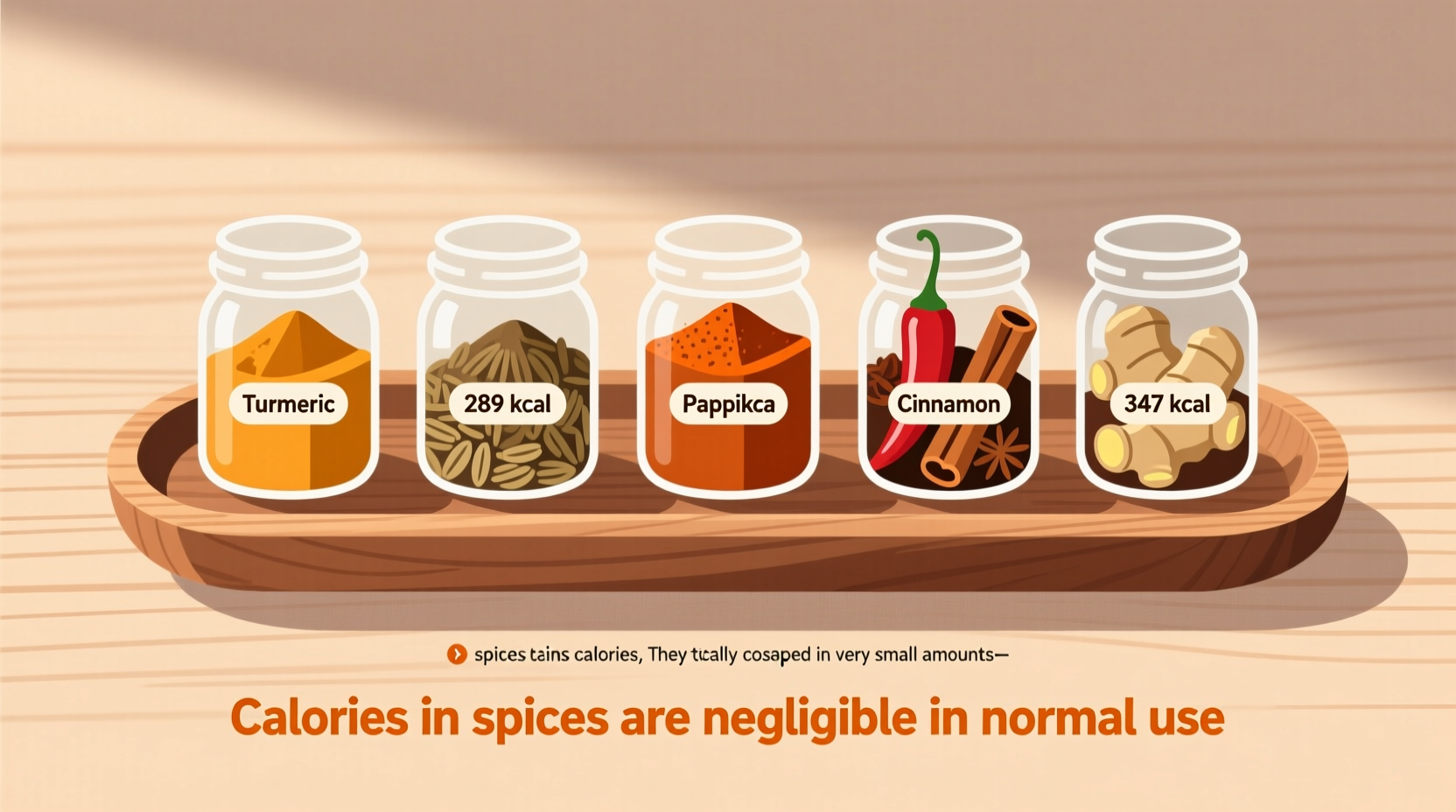Why Spices Won't Derail Your Calorie Counting Goals
When you're tracking calories, every bite counts—but spices operate in a different nutritional universe. Unlike oils, sugars, or even most vegetables, spices deliver intense flavor with almost no caloric cost. This makes them indispensable tools for flavoring meals without compromising dietary goals.
Understanding Spice Calorie Content: The Science Simplified
Spices contain minimal calories because they're primarily composed of water, fiber, and volatile compounds that provide flavor but negligible energy. When you measure a teaspoon of ground turmeric or paprika, you're mostly measuring air between particles—not dense, calorie-rich material.
According to USDA FoodData Central, the caloric density of dried spices ranges from 0.2 to 3 calories per gram—significantly lower than most foods. Compare this to:
- Fats: 9 calories per gram
- Carbohydrates: 4 calories per gram
- Proteins: 4 calories per gram
The reason? Spices consist mainly of indigestible plant fibers and water. Your body extracts minimal energy from these components, explaining their negligible caloric impact.
| Common Spice | Calories per Teaspoon | Calories per Tablespoon | Primary Composition |
|---|---|---|---|
| Cinnamon | 6 | 18 | 75% fiber, 10% water |
| Paprika | 2 | 6 | 80% fiber, 8% water |
| Cumin | 8 | 24 | 60% fiber, 10% protein |
| Garlic Powder | 4 | 12 | 70% carbohydrates, 15% fiber |
| Cayenne Pepper | 1 | 3 | 85% fiber, 5% water |
Source: USDA FoodData Central (2023)
Practical Calorie Management: How Spices Fit Into Your Diet
Consider this real-world scenario: Adding a teaspoon of cumin (8 calories) to your entire pot of chili affects the per-serving calorie count by less than 1%. For someone consuming 2,000 calories daily, this represents just 0.4% of their total intake—less than the margin of error in most calorie tracking apps.
Nutrition researchers at Harvard T.H. Chan School of Public Health confirm that spice calories become nutritionally insignificant at typical usage levels. Their analysis shows you'd need to consume more than 3 tablespoons of most spices daily before calories warrant consideration in meal planning.
Spice Calorie Myths Debunked
Myth: "Spices with 'heat' like cayenne pepper burn calories and should count as negative calories."
Fact: While capsaicin in hot peppers may slightly increase metabolism, the effect is minimal—about 50 calories burned after consuming extremely spicy foods. This doesn't make spices "negative calorie," but their negligible caloric content remains unchanged.
Myth: "Blended spice mixes contain hidden calories."
Fact: Pure spice blends (like curry powder or garam masala) maintain minimal calories. However, commercial blends sometimes add salt, sugar, or starches. Always check labels for "spice" as the sole ingredient to ensure true calorie-free status.

Maximizing Flavor Without Calorie Concerns
Professional chefs leverage spices' calorie efficiency through these techniques:
- Dry-toasting whole spices before grinding releases maximum flavor compounds without adding oil or calories
- Creating spice-infused waters for cooking grains or vegetables adds flavor with zero caloric impact
- Layering spices at different cooking stages maximizes perceived flavor intensity while minimizing quantity needed
- Using acid-spice combinations (like lemon-cumin) creates flavor complexity that tricks the palate into perceiving stronger seasoning
These methods allow professional kitchens to maintain bold flavors while meeting strict nutritional guidelines—a technique equally valuable for home cooking.
When Spice Calories Might Matter
For 99% of people, spice calories are nutritionally irrelevant. However, specific medical conditions create exceptions:
- Individuals on medically supervised 500-calorie-per-day diets
- Patients with short bowel syndrome requiring extreme nutrient density
- Athletes in precise weight-class sports where every calorie counts
Even in these cases, registered dietitians typically recommend continuing spice use for flavor and potential health benefits, adjusting other dietary components instead.
Spices and Metabolic Health: Beyond Calorie Counting
Research published in the Journal of Nutritional Science demonstrates that certain spices may positively influence metabolic health. Cinnamon shows potential for improving insulin sensitivity, while turmeric's curcumin may reduce inflammation. These benefits occur at typical culinary doses—without meaningful caloric contribution.
This dual advantage—flavor without calories plus potential health benefits—makes spices uniquely valuable in nutrition planning. As Dr. David Ludwig of Harvard Medical School notes: "Spices represent one of the few food categories where we get significant benefits with virtually no metabolic cost."
Practical Spice Usage Guidelines for Calorie-Conscious Eaters
Follow these evidence-based recommendations for incorporating spices without calorie concerns:
- Use 1-2 teaspoons of single spices per serving without tracking
- Limit blended spice mixes to 1 tablespoon per meal unless checking labels
- Prefer whole spices ground fresh—they contain slightly fewer calories than pre-ground versions
- Combine spices with vinegar or citrus to enhance perceived intensity
- Store spices properly to maintain potency—fresher spices require less quantity for equivalent flavor
Remember that the psychological benefit of flavorful food often outweighs minuscule caloric costs. Studies show people following restrictive diets are 40% more likely to maintain adherence when meals include robust seasoning—a crucial factor often overlooked in pure calorie counting.











 浙公网安备
33010002000092号
浙公网安备
33010002000092号 浙B2-20120091-4
浙B2-20120091-4